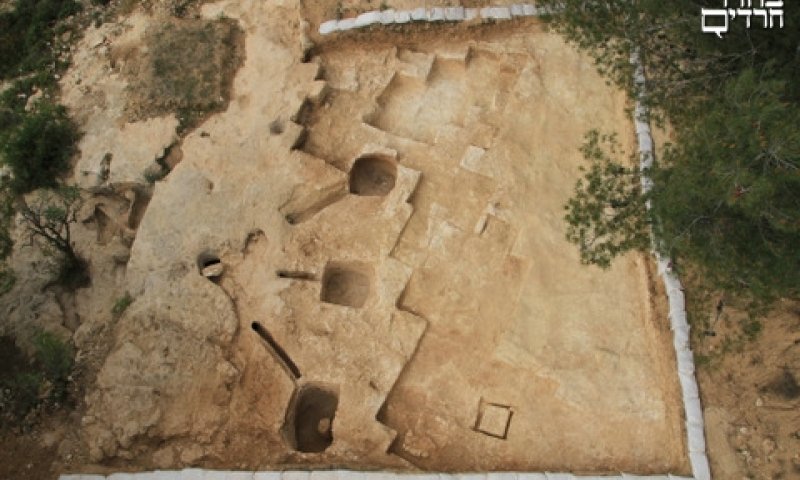
In center of Jerusalem recently discovered a m ikveh from Bayis Sheni
Archaeological excavation in the Kiryat Menachem neighborhood, discovered a rare mekveh from the time of Bayis Sheni • "the mikveh meets all the kashrus standards, and is built sophisticatedly and complexly"
- Yoel Koritz, B'Chadrei Charedim
- א' אייר התשע"ג

Archaeological excavation the Israel Antiquities Authority in Jerusalem, Kiryat Menachem neighborhood, before paving of the street promoted by the Moriah Company, a rare mikevh was exposed from the time of Bayis Sheni.
According to Benjamin Stortzan, excavation director on behalf of the Israel Antiquities Authority, "In recent years many mikvehs were excavated in Jerusalem, but the water feed system we exposed in this excavation is unique and unusual. The mikveh consists of an underground cavity which is led by stairs. The desired rainfall is received by three basins watersheds (Treasury) which were hewn on the desired ceiling, and poured the fresh water through the channels into the desired space.
"The mikvehs known so far are often composed of a closed space which it channeled rainwater in a small pond excavated nearby. System exposed now is sophisticated and more complex. The mikveh is possibly linked to a settlement point which was in place during the period of Bayis Sheni. Likely, due to the regime of rainfall and drought in the area, settlers were looking for special techniques to allow storing every drop of water. It is interesting to note that the mikveh is according to all the laws of kashrus, such as water drainage naturally without human intervention, and ensuring that water does not seep into the depths of the earth, for which the mikveh was coated with a special plaster."
The mikveh, which is in a picturesque valley where there are ancient agricultural installations, revealed a step away from the Kiryat Menachem neighborhood. According to the Jerusalem District Archaeologist, Amit Ram, "a neighborhood community expressed great interest in preserving the mikveh. Antiquities Authority and Moriah Company are operating to turn the mikveh to the welfare of residents and visitors."
After the mikveh was not used, it served as a quarry, and the canals were filled with dirt. During the 20th century, the mikveh was cleared, a round opening was breached in the ceiling and it served as a water cistern.
According to Benjamin Stortzan, excavation director on behalf of the Israel Antiquities Authority, "In recent years many mikvehs were excavated in Jerusalem, but the water feed system we exposed in this excavation is unique and unusual. The mikveh consists of an underground cavity which is led by stairs. The desired rainfall is received by three basins watersheds (Treasury) which were hewn on the desired ceiling, and poured the fresh water through the channels into the desired space.
"The mikvehs known so far are often composed of a closed space which it channeled rainwater in a small pond excavated nearby. System exposed now is sophisticated and more complex. The mikveh is possibly linked to a settlement point which was in place during the period of Bayis Sheni. Likely, due to the regime of rainfall and drought in the area, settlers were looking for special techniques to allow storing every drop of water. It is interesting to note that the mikveh is according to all the laws of kashrus, such as water drainage naturally without human intervention, and ensuring that water does not seep into the depths of the earth, for which the mikveh was coated with a special plaster."
The mikveh, which is in a picturesque valley where there are ancient agricultural installations, revealed a step away from the Kiryat Menachem neighborhood. According to the Jerusalem District Archaeologist, Amit Ram, "a neighborhood community expressed great interest in preserving the mikveh. Antiquities Authority and Moriah Company are operating to turn the mikveh to the welfare of residents and visitors."
After the mikveh was not used, it served as a quarry, and the canals were filled with dirt. During the 20th century, the mikveh was cleared, a round opening was breached in the ceiling and it served as a water cistern.
תגובות
{{ comment.number }}.
הגב לתגובה זו
{{ comment.date_parsed }}
{{ comment.num_likes }}
{{ comment.num_dislikes }}
{{ reply.date_parsed }}
{{ reply.num_likes }}
{{ reply.num_dislikes }}



הוספת תגובה
לכתבה זו טרם התפרסמו תגובות